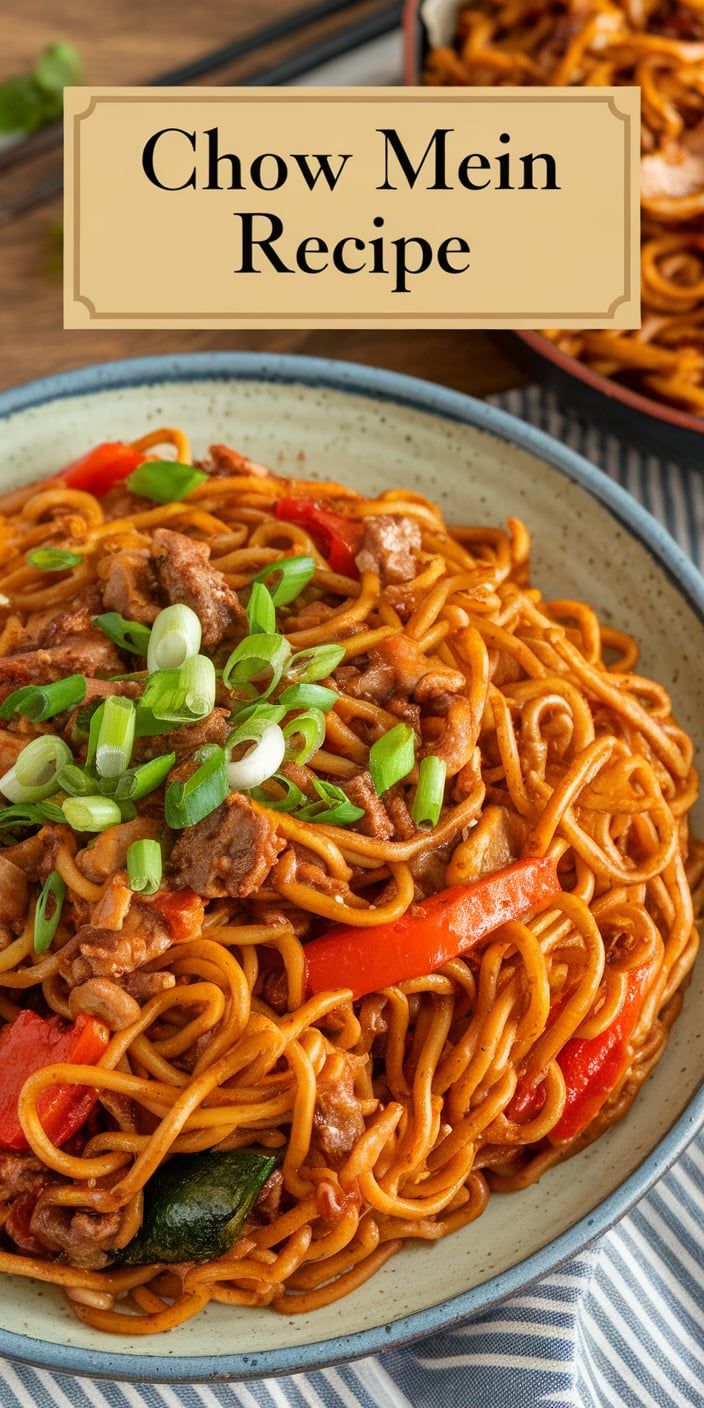Welcome to the ultimate homemade Chow Mein recipe that will transform your kitchen into a Chinese culinary paradise! As a passionate home cook, I’ve perfected this authentic Chinese noodles dish that captures the heart of traditional cooking. Chow Mein isn’t just a meal – it’s an experience that brings together incredible flavors and textures in one delightful plate.
My journey with this Chow Mein recipe began during a memorable trip to San Francisco’s Chinatown, where I discovered the magic of true Chinese cuisine. The crispy noodles, vibrant vegetables, and perfect seasoning sparked my passion for creating an authentic homemade Chow Mein that could rival any restaurant dish.
What makes this recipe special is its simplicity and depth of flavor. You’ll learn how to create a restaurant-quality meal right in your own kitchen, using techniques that have been passed down through generations of Chinese home cooks. Whether you’re a novice or an experienced chef, this Chow Mein recipe will become a staple in your cooking repertoire.

What Makes Chinese Chow Mein Special
Chow Mein represents a culinary journey through Chinese gastronomy, capturing centuries of cooking traditions and regional diversity. This iconic dish tells a rich story of flavor, technique, and cultural adaptation that extends far beyond simple noodle preparation.
Origins and Cultural Significance
The Chinese Chow Mein history traces back to the Han Dynasty, where noodle-making became a sophisticated culinary art. Originating in Northern China, this dish emerged as a staple food for travelers and workers seeking nutritious, portable meals. Wheat noodles became the foundation of what we now recognize as Chow Mein, symbolizing resourcefulness and innovation in Chinese cuisine.
Different Regional Variations
Regional Chow Mein variations showcase the incredible diversity of Chinese cooking styles. Each province offers a unique interpretation:
- Cantonese Chow Mein: Crispy, pan-fried noodles with light sauce
- Sichuan Chow Mein: Spicy version with bold pepper flavors
- Shanghai Chow Mein: Softer noodles with rich meat combinations
Authentic vs. Western-Style Chow Mein
Authentic Chow Mein differs significantly from Western adaptations. Traditional Chinese preparation emphasizes fresh ingredients, delicate seasoning, and precise cooking techniques. Western versions often feature heavier sauces and simplified ingredient lists.
| Authentic Chow Mein | Western Chow Mein |
|---|---|
| Fresh, hand-pulled noodles | Pre-packaged dried noodles |
| Minimal sauce | Heavy, sweet-tangy sauce |
| Seasonal vegetables | Standard vegetable mix |
Essential Ingredients for Perfect Chow Mein Recipe
Creating an authentic Chow Mein dish starts with selecting the right Chow Mein ingredients. I’ll guide you through the key components that make this classic Chinese stir-fry truly delicious.
Noodle Types for Chow Mein
The foundation of any great Chow Mein is choosing the right noodles. I recommend these top noodle options:
- Fresh egg noodles (thin or medium width)
- Dried Chinese wheat noodles
- Hong Kong-style pan-fried noodles
- Crispy noodle varieties for added texture
Essential Chow Mein Vegetables
Chow Mein vegetables are crucial for creating depth and nutrition in the dish. My favorite vegetable selections include:
- Crisp cabbage
- Julienned carrots
- Green onions
- Bean sprouts
- Sliced celery
Protein and Sauce Ingredients
To elevate your Chow Mein, I suggest incorporating protein and a flavorful sauce:
| Protein Options | Sauce Components |
|---|---|
| Sliced chicken breast | Light soy sauce |
| Beef strips | Dark soy sauce |
| Shrimp | Oyster sauce |
| Tofu | Sesame oil |
Pro tip: Always use fresh, high-quality ingredients to ensure your Chow Mein bursts with authentic flavor and texture.
Kitchen Tools and Preparation Tips
Creating authentic Chow Mein requires the right Chow Mein cooking tools and careful preparation. Understanding the essential kitchen equipment and techniques can transform your home cooking experience and elevate your dish to restaurant-quality standards.
Wok Selection and Care
Selecting the perfect wok for Chow Mein is crucial for achieving authentic flavor and texture. I recommend a carbon steel wok for its superior heat distribution and durability. When choosing a wok, consider these key factors:
- Size: 14-inch woks work best for home cooking
- Material: Carbon steel provides optimal heat retention
- Handle type: Long wooden handles prevent heat transfer
Proper wok maintenance involves seasoning and careful cleaning. Always dry your wok completely after washing to prevent rust and apply a thin layer of cooking oil to maintain its non-stick surface.
Noodle Preparation Techniques
Noodle preparation is a critical step in creating delicious Chow Mein. I prefer using fresh egg noodles for the most authentic texture. Here are my top noodle preparation tips:
- Soak dried noodles in warm water for 15-20 minutes
- Par-boil fresh noodles for 1-2 minutes
- Drain and rinse with cold water to stop cooking
- Toss with a little oil to prevent sticking
Vegetable Cutting Methods
Uniform vegetable cuts ensure even cooking and an appealing presentation. Use these cutting techniques for perfect Chow Mein vegetables:
| Vegetable | Cutting Technique | Ideal Size |
|---|---|---|
| Carrots | Julienne | 2-inch thin strips |
| Cabbage | Chiffonade | Thin, long ribbons |
| Bell Peppers | Diagonal slice | 1/4-inch thick |
Step-by-Step Cooking Instructions
Learning how to cook Chow Mein requires mastering a few key techniques. The Chow Mein cooking process starts with proper preparation and quick stir-frying. I’ll guide you through creating an authentic dish that captures the essence of traditional Chinese cuisine.
Before you begin stir-frying noodles, gather all your ingredients and prep work. I recommend having everything chopped and ready to go, as the cooking process moves quickly.
- Prepare the noodles by boiling them until just al dente, then drain and rinse with cold water to stop cooking
- Heat your wok or large skillet on high heat with vegetable oil
- Cook proteins first (chicken, beef, or tofu) and remove from the pan
- Stir-fry vegetables quickly, keeping them crisp and vibrant
- Return proteins to the pan and add pre-cooked noodles
- Toss everything together with your prepared sauce
The secret to perfect Chow Mein is maintaining high heat and constant movement. Keep your ingredients moving in the wok to prevent burning and ensure even cooking. A well-seasoned wok can make a significant difference in developing deep, rich flavors.
When stir-frying noodles, aim for a slight crisp on the edges while keeping the center tender. The goal is to create a harmonious blend of textures that makes Chow Mein so delightful.
Serving Suggestions and Flavor Variations
When serving Chow Mein, I love to get creative with presentation and flavor profiles. My go-to Chow Mein serving ideas include pairing the dish with steamed white rice or crispy spring rolls to create a more substantial meal. Garnishing with fresh green onions, sesame seeds, or a sprinkle of chili flakes can instantly elevate the visual appeal and taste.
Exploring Chow Mein variations allows for incredible culinary flexibility. I recommend trying a spicy Sichuan-style version by adding Szechuan peppercorns or a vegetarian option packed with colorful bell peppers, mushrooms, and tofu. You can easily customize Chow Mein recipe based on dietary preferences or seasonal ingredients available in your kitchen.
For those looking to experiment, consider alternate protein options like shredded chicken, beef, or shrimp. Gluten-free home cooks can substitute wheat noodles with rice noodles, and vegetable lovers might prefer a vibrant mix of seasonal produce. Storing leftover Chow Mein is simple – refrigerate in an airtight container and reheat quickly in a hot wok to maintain its crispy texture.
Remember that the beauty of Chow Mein lies in its adaptability. Don’t be afraid to experiment with different sauces, proteins, and vegetables to create a dish that reflects your personal taste and culinary creativity.
